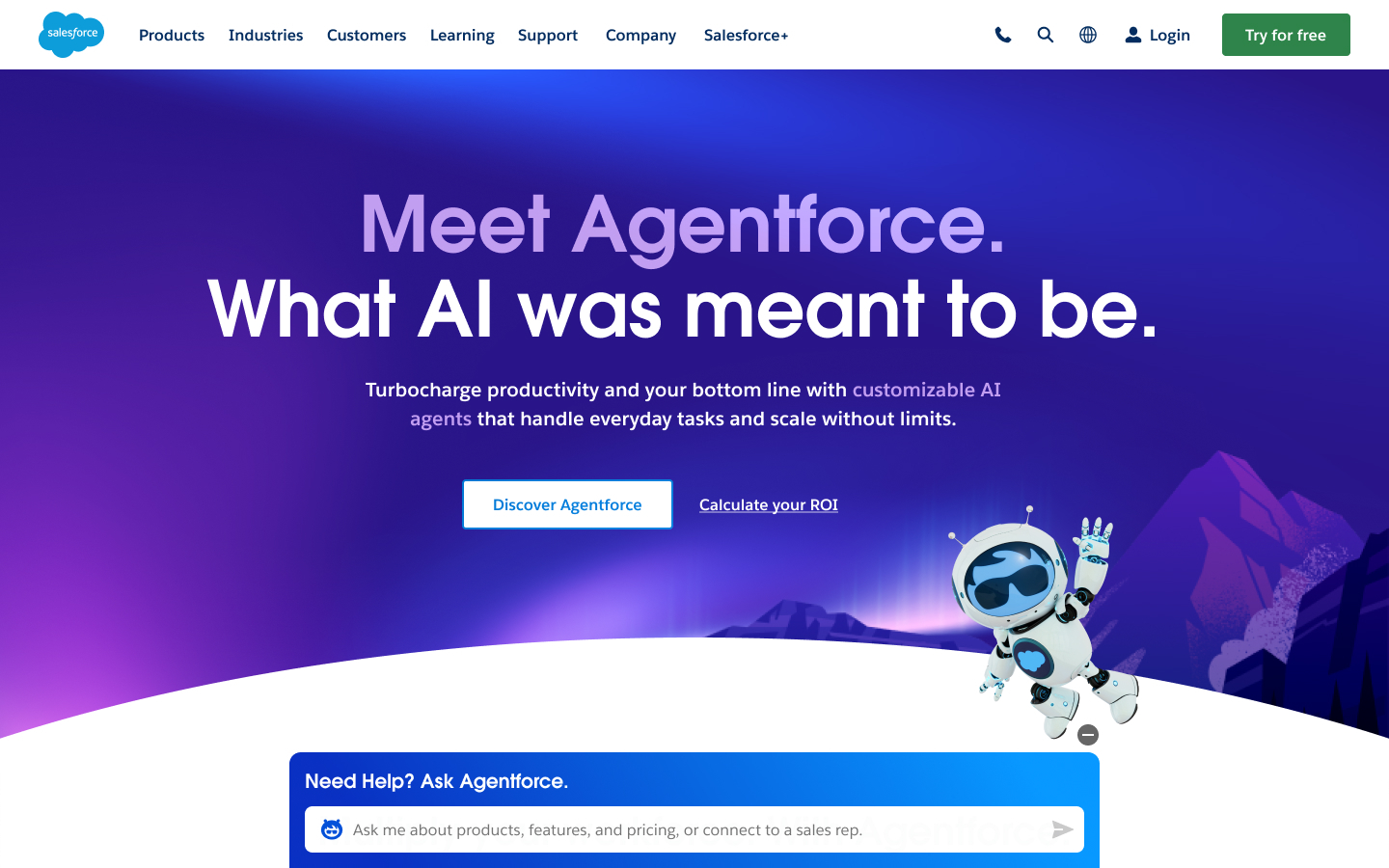We Launched an Agent Across Our Site — Here’s What We Learned

Browsing and searching puts the onus on users to find what they need on your site. What if the website came to them?
Is there anything more frustrating than typing a query into the search bar of a company’s website, only to get an irrelevant response or, worse, no result at all? It shouldn’t be that hard. That’s why Salesforce is experimenting with Agentforce, the digital labor platform, on a new web experience for Salesforce.com that will take the burden off users to find what they’re looking for.
Picture this: Instead of using the search bar to ask a question that — maybe — gets answered satisfactorily, you ask Agentforce a question in plain language. It scours the site to answer your question, and then does so, right in the Agent window — no need to click to another page. If needed, the agent connects you with a human sales development rep (SDR), who can provide a custom quote, make sure a product fits your needs, and so on. Agentforce chat gives the SDR the context they need to further answer your request.
This new experience is miles ahead of onsite search in more fundamental ways, as well. For example, if you type “Who is the CFO of Salesforce?” into the search bar on Salesforce.com, the first result you get is the article “Becoming a Customer-Centric CFO in the Digital Age.” Nowhere in the multiple pages of results does onsite search correctly answer your question.
Ask Agentforce the same question, and you get “The CFO of Salesforce is Amy Weaver. You can read more about her here,” with a link to her bio.
That’s a simple example, but imagine a customer searching for information on how to upgrade their service plan. If they don’t get the results they need right away, they may lose patience and bail, taking their business with them.
This short video shows Agentforce in action.
“We are bringing content and answers directly to customers, versus them having to go and search for it,” said Dana Greenberg, senior director of product management at Salesforce. “We don’t want to put the burden on a visitor on our site to go and hunt down content and look through lists of links to find what they need.”
Why we did it
Visitors to your site deserve a better way to find relevant information. Today’s tools just don’t cut it.
Traditional site search, navigation, and chatbots are only moderately helpful in connecting site visitors with the information they need. Search accuracy relies on keyword matching, which often results in irrelevant results if the user doesn’t know what to look for or the exact term to search. Navigation structures tend to be rigid, requiring users to sift through menus and pages. And chatbots have limited functionality, with predefined scripts that can’t handle unexpected or more complex queries. All these tools have been around for years, largely unchanged, and lack the personalization, accuracy, and scale that AI delivers.
Late last year, Salesforce began testing its agent on its support site and saw an immediate payoff. Agentforce handles more than 30,000 customer conversations every week, resolving over 80% of cases and escalating fewer than 1% to a human. By piloting its own technology — the company is customer zero for Agentforce — Salesforce gains valuable insight to refine the tools and improve them for broader adoption.
As a work in progress, Agentforce now has a new user interface that’s larger and more conducive to a conversation. The first iteration resembled a chatbot, a small box tucked in the lower corner of the screen. The new version is full screen, with a more prominent dialog box that expands when the results populate the canvas. Users have the option to push the canvas to the side of the screen.

“Agentforce will fundamentally change navigation and search,” said Sharat Radhakrishnan, principal architect at Salesforce. “Users shouldn’t have to figure out your website structure. Our idea is that you come to the agent, ask it a question, and the answer comes to you right in the agent. There is no browsing or searching.”
Eventually, Agentforce will answer many product questions, leaving SDRs with more time to focus on qualified leads.
How we did it, and what we learned
Data Cloud, a platform for unifying and harmonizing data from across the enterprise, is the foundation of Agentforce. Three data streams — product catalog, website content, and customer stories — were identified as the best initial knowledge sources for Agentforce. New content from these streams is continually and automatically added to Data Cloud, which then feeds Agentforce.
Agentforce uses the Atlas Reasoning Engine and retrieval augmented generation (RAG) to execute combined semantic search on structured data, like product catalogs, and unstructured data, like website content. If a user asks Agentforce about Sales Cloud, it pulls from the unstructured website content to respond. If they ask, “How much does it cost?” Agentforce understands the context, selects the right product details from the structured product catalog, and delivers an accurate answer. It seamlessly links unstructured and structured data using existing text, identifiers, and tags.
In the future, additional knowledge sources from around the site, including different content types like video, will be added to Agentforce, enhancing the richness of the experience.
Radhakrishnan said certain responses must be 100% deterministic 100% of the time. This means they can never vary from one query to another, and must be completely accurate. Examples would be pricing, and terms and conditions. Responses for other queries, such as “How can I improve the efficiency of my service team?”, can be more probabilistic, meaning some variances in responses are acceptable.
As Agentforce is being refined, three key learnings have emerged. It’s important to figure out:
- how to contextualize responses based on who the user is, and where the agent is being used,
- how teams of different agents across business units will work together, and
- how to add more knowledge sources to the agent.
The heavy lifting is in determining which authoritative content sources are best to feed your agent. This requires a sitewide audit (keep in mind that some content may be outdated). Radhakrishnan recommends expanding your view beyond standard website fare. Consider, for example, product messaging slides, documents used by the sales team, and even Slack workstreams.
Give customers the information they need, faster
Both Greenberg and Radhakrishnan said overhauling the web experience this way makes great business sense, since Agentforce can easily connect salespeople with qualified buyers. Plus, easing the discovery process for users could result in longer time spent on the site, and deeper engagement.
“This is an entirely new experience,” said Greenberg. “We’re flipping the script to bring users the content they want, based on what they’re telling us they want.”





























